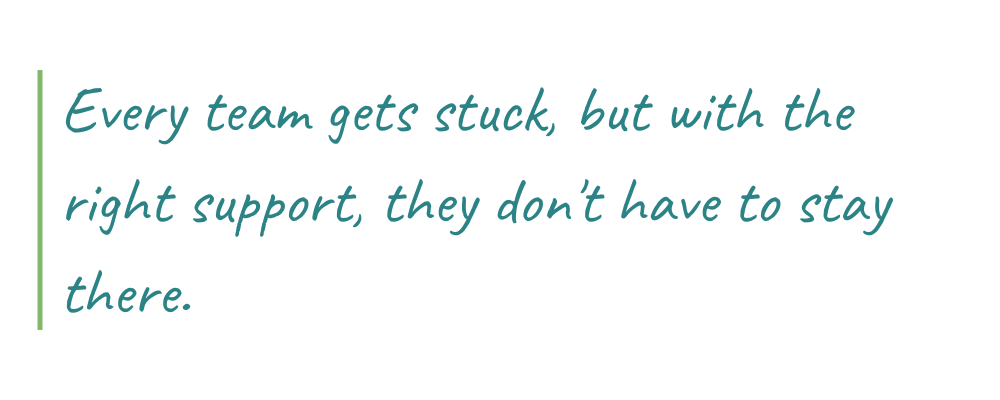Is Your Team Stuck? A Facilitator Can Help
Many of us have ‘been there’ as leaders. You show up to work hoping to make a change and do your best to support your team, but despite all the goals and good intentions, momentum just isn't building. It's frustrating to feel stuck and unable to lead your team as you truly want to and envision.
We hear it a lot –frustrated leaders stepping in to facilitate their offsites or workshops. While we get the instinct, the hard truth is that so much potential gets lost in that decision. Leading your team and facilitating at the same time often comes at a cost.
Although not cheap, a skilled facilitator brings so much value that it more than justifies the investment. With the right facilitator, you create the conditions for honest dialogue, shared clarity, and actual movement with your team, making it worth your ROI.
Sometimes, the best support doesn't come from within but from outside expertise. And that's not a failure; it’s a wise leadership move! Recognizing when your team needs something different is a moment to be proud of. As leaders, our job is to serve our team and do what best supports their growth. At times, we all need a leadership partner who can step back, see the bigger picture, and help us move our team forward. A facilitator can make a difference.
Whenever I mention facilitation as part of my leadership development work with teams, I often hear something like, "That's so cool... but what does that actually mean?" And honestly, I love that question because the role of a facilitator is so versatile. A facilitator plays a strategic and people-centered role, fully focused on helping your team, especially when things feel stuck, or even before they do.
Here are a few ways facilitators like us support teams in finding clarity and movement when they are stuck.
1. Create Alignment - Get everyone’s efforts pointed in the same direction
We've all been on teams where the goal is clear, but everyone seems to be moving in different directions. Misalignment can manifest in many ways, such as unclear priorities, confusion around responsibilities, misunderstandings, or a lack of follow-through.
This is a perfect opportunity for a facilitator to step in. The facilitator creates and protects space for people to be heard, share ideas, and build understanding. They help teams create alignment. Because they’re neutral and not tied to internal dynamics or specific outcomes, they enable teams to have honest conversations and often leave them with more clarity, stronger collaboration, and a renewed sense of purpose.
2. Make Progress - You’d be surprised how much more gets done
At a workshop we designed and facilitated last year, one participant said they couldn't believe how much the participants accomplished in just two hours. That kind of energy and momentum is possible with a professional meeting design that brings structure and clarity, and an expert intentionally guides the way.
Facilitators help keep conversations focused and meaningful. They guide teams to own and focus on the priorities, work through challenges, and leave with clear next steps. That kind of direction can be invaluable when time is tight and there's much to accomplish.
3. Bring in New Energy - Shake things up with an outsider
When a team works together for a while, it's easy to fall into the same routines and habits. At some point, the ways team members communicate, collaborate, and make decisions may have worked before, but these habits may no longer serve the team's growth.
A facilitator brings fresh energy into the room. They’re trained to ask different kinds of questions, invite in new voices, and help people look at challenges in ways they might not have considered. That shift in perspective can open up new ideas and lead to realizations that move the team forward.
Every team gets stuck, but with the right support, they don't have to stay there. Consider it a time to try something different. Partnering with a facilitator gives your team the space to pause, reconnect, and move forward with clarity and purpose.
The first step is to set up a consultation. We’re here to help!


